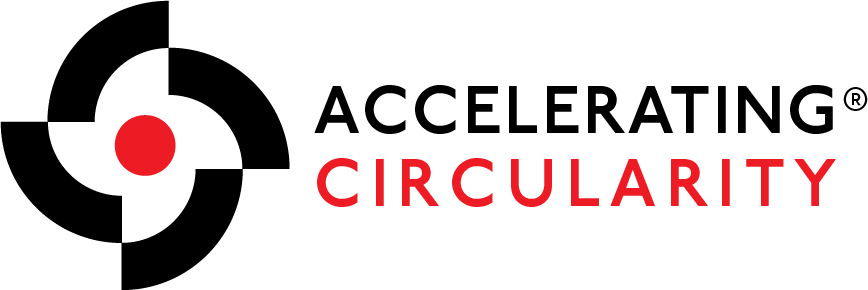First Gaps, Now Leaps
A bridge is constructed from both sides of a river. Footings get poured, and the slow, methodical process of breaching a distance is realized, brick by brick, with imagination and form, subject to the laws and limits of physics.
And . . . in the words of Nelson Mandela, “It always seems impossible until it’s done.”
As the Accelerating Circularity Project heads into its next phase of modeling and pilots, radical transparency, pre-competitive collaboration, and shared vision are our daily bread. To keep us focused, we have a little chart. It maps the way that data leads to information, information leads to answers to who, what, where, and when. Those answers lead to, “How?” How will we model pilots in order to best provide the answer to the question of why? Why shift to a circular supply chain? Why invest? Why change?
We have learned many things, measured, weighed, and mapped. But this is not the goal! Circularity is the goal. This is an act. We are writing the script as we go. Just as actors support each other with the invitation to the next line, our work relies the support and participation of every party on the stage.
So, don’t look over your shoulder. Don’t look ahead to the distant horizon. Look at your own two feet, on your side of the river, and start to build!
Accelerating Circularity will continue its commitment to frequent and urgent working sessions where we collaborate with industry to write new guidelines for sorting, categorize methods and outputs for recycling, clarify language, and visualize the industry’s next steps. Brands, Collectors, Sorters, Pre-Processors, Recyclers, Suppliers! Please let us know if you would like to participate in these sessions.
A new roadblock (or opportunity for collaboration) is becoming clear. Recycling for circularity requires consistent quantity and quality of feedstocks. We must establish a system to collect, preprocess, and accumulate the appropriate volume of raw materials that textile-to-textile recyclers require in order to operate effectively. There is a practical necessity for aggregation of collection in order to syphon and blend fibers to the correct ratios so that recycling processes can run at scale. This will take coordination, new infrastructure, and possibly a change of course for some brands who may still be hoping that they can recycle their own products in a closed loop.
What environment is needed to yield high value aggregation?
Hubs: aggregation and distribution centers with specialized collection and processing for textile-to-textile.
Purposeful Sortation and Preprocessing: avoiding multiple re-sorts, i.e., clear sorting guidelines, feedstock restrictions, and end markets.
Setting Rules of Engagement: how does a system for aggregation operate? This is a new area for development.
In order to build models for scaling textile-to-textile recycling, and run them in pilots, we need your participation, knowledge, and a deeper understanding of your roadblocks. Talk to each other. Talk to us. Let’s make some new knowledge and then let’s share it.
If you haven not already, please take a moment to complete our surveys currently posted on the website. We have surveys for Brands & Retailers, Collectors & Sorters, Preprocessors, and Recyclers.
Make your contribution to the development of circular systems by disclosing your material content here.
COLLECTORS & SORTERS; PREPROCESSORS
Help us capture the right requirements, please comment on and contribute to our draft specifications.
Register your comments on the categories we have outlined to date.
We have learned many things, measured, weighed, and mapped. But this is not the goal! Circularity is the goal. This is an act. We are writing the script as we go. Just as actors support each other with the invitation to the next line, our work relies the support and participation of every party on the stage.
So, don’t look over your shoulder. Don’t look ahead to the distant horizon. Look at your own two feet, on your side of the river, and start to build!
Accelerating Circularity will continue its commitment to frequent and urgent working sessions where we collaborate with industry to write new guidelines for sorting, categorize methods and outputs for recycling, clarify language, and visualize the industry’s next steps. Brands, Collectors, Sorters, Pre-Processors, Recyclers, Suppliers! Please let us know if you would like to participate in these sessions.
A new roadblock (or opportunity for collaboration) is becoming clear. Recycling for circularity requires consistent quantity and quality of feedstocks. We must establish a system to collect, preprocess, and accumulate the appropriate volume of raw materials that textile-to-textile recyclers require in order to operate effectively. There is a practical necessity for aggregation of collection in order to syphon and blend fibers to the correct ratios so that recycling processes can run at scale. This will take coordination, new infrastructure, and possibly a change of course for some brands who may still be hoping that they can recycle their own products in a closed loop.
What environment is needed to yield high value aggregation?
Hubs: aggregation and distribution centers with specialized collection and processing for textile-to-textile.
Purposeful Sortation and Preprocessing: avoiding multiple re-sorts, i.e., clear sorting guidelines, feedstock restrictions, and end markets.
Setting Rules of Engagement: how does a system for aggregation operate? This is a new area for development.
In order to build models for scaling textile-to-textile recycling, and run them in pilots, we need your participation, knowledge, and a deeper understanding of your roadblocks. Talk to each other. Talk to us. Let’s make some new knowledge and then let’s share it.
If you haven not already, please take a moment to complete our surveys currently posted on the website. We have surveys for Brands & Retailers, Collectors & Sorters, Preprocessors, and Recyclers.
Make your contribution to the development of circular systems by disclosing your material content here.
COLLECTORS & SORTERS; PREPROCESSORS
Help us capture the right requirements, please comment on and contribute to our draft specifications.
Register your comments on the categories we have outlined to date.
